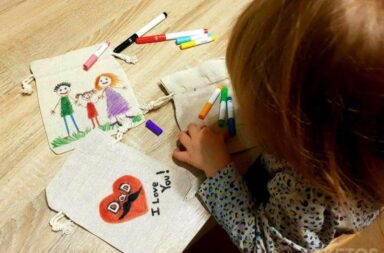Make your own sensory bags with your child! Learn how to sew them and what to fill them with!
There’s no doubt everyone remembers small bags filled with peas from their childhood. They were used mainly during PE and corrective gymnastics classes.
This simple toy is, in fact, an educational aid that offers great opportunities! Sensory bags can be an inspiration for many great games facilitating the child’s development, as well as a great therapy tool. Learn how to make sensory bags at home!
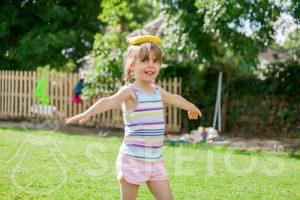
Gymnastics grip bags – balance exercise
What’s the benefit of sensory bags? Why use them?
“What’s not in your senses first, is not in your mind later.” – Maria Montessori
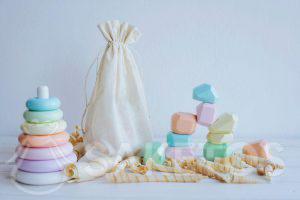
Montessori-style aids in a small linen eco-bag
Touch bags are a very versatile aid in line with the Montessori philosophy. Their form is simple and they’re extremely versatile! They provide the child with many different sensory experiences. Depending on the choice of game/exercise, they develop the child’s locomotor system and stimulate different senses.
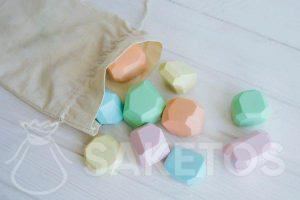
Sensory bags – a linen bag with wooden shapes
When used properly, they have a positive influence on large and small motor skills, body balance, balance, coordination, concentration, proprioceptive sensation, the senses of touch, sight and hearing (the sounds of objects moving inside the bag are different depending on the filling used).
The list of the benefits of their use is impressive! Just as long is the list of their application possibilities. It seems that the only limitation is our imagination. They can be used for various developmental games and corrective exercises. Moreover, they’re commonly used in the SI therapy. They’re perfect for playing with children with tactile hypersensitivity – a child examining the bag with their hands is exposed to many stimuli without getting their hands dirty.
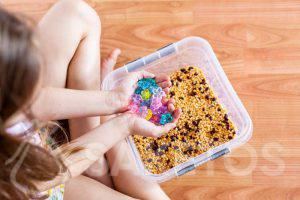
Sensory games for children
How to make DIY sensory bags?
Wondering how to sew sensory bags? Are you worried, however, that you lack manual skills? You also probably think that you’ll need a lot of time and money to make them. Neither of that! Fabric bags from Saketos come in handy. Thanks to them, you can create your own sensory bags in a matter of moments!
How to make them? It’s very simple! Just put the content of your choice into the bags, tie the strings in a knot and you’re done! Thanks to the use of ready-made pouches, it’ll take only a few moments to create your own sensory bags! What’s more, tying them in a knot makes it possible to empty them after the game, which means you can use them again in the future!
As for sensory bags for babies and small children, it’s a good idea to secure them by sewing up the top of the bag. Due to the small elements inside the bags, a child under the age of 3 should always play with a sensory bag under the care of an adult.
What should you fill sensory bags with?
Using various kinds of filling for the bags is intended to provide the child with rich sensory experiences. Since individual pouches differ in content, they provide diverse auditory and tactile stimuli. Because sensory bags filled with objects such as buttons will provide different tactile sensations and different sound effects than bags containing rice. So, what can you put in your sensory bags?
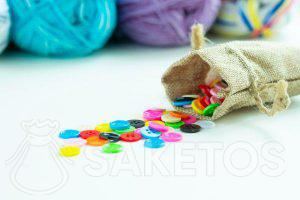
Coloured buttons in a jute bag
Ideas for things to fill your sensory bags:
- Natural materials: peas, rice, various kinds of groats, beans, lentils, chickpeas, pasta, coffee beans, nuts, chestnuts, acorns, small cones, gravel, pebbles, or sand.
- Other items: sequins, beads, buttons, polystyrene foam, glass balls, beverage caps, colourful pompoms, building blocks and small toys such as animal figures, also suitable for some games.
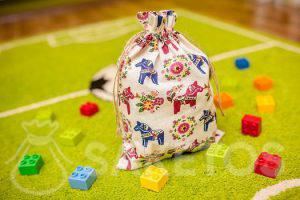
A decorative bag for the children’s room to store Lego Duplo blocks
- The contents of sensory bags can be examined with all senses! So, consider also creating a collection of scented bags filled with different kinds of dried herbs for your child!

Scented bags
What kind of fabric to choose for sensory bags?
Virtually all the bags you find in the Saketos store are suitable for making sensory bags. However, the final result depends on the selection of fabric. Different types of bags will give you a variety of fun options.
- Organza bags: Thanks to its transparency, organza provides an excellent presentation of its contents. When you play with bags made of organza, you can clearly see the contents, which stimulates the sense of sight. For example, you can put different coloured buttons, shiny sequins and coloured beverage caps in organza bags.
- Bags made of opaque fabrics: Pouches made of opaque fabrics are also suitable as sensory bags. They let you concentrate better on your sense of touch. Exploring them requires even more focus from the child. Examining the bag by touching to guess what’s inside requires a lot of commitment from the child. You can provide the stimulation of visual functions by choosing bags in different colours.
You may also want to consider the purchase of bags made of a variety of fabrics. Instead of concentrating on what to fill the sensory bags with, you can put the same content into all of them, as fabrics featuring varied textures in themselves provide excellent stimulation. When choosing bags made of organza and satin, velour, denim and jute, you get 5 very different fabrics providing different tactile stimuli. It’s also great wrapping for a felt 3D memory set.
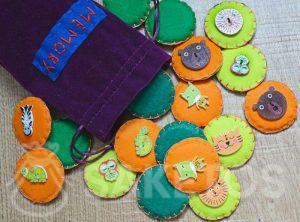
8. Felt memory in a velour pouch
How to look after sensory bags?
Bags that were sewn up with a natural filling (e.g. rice) can’t be washed. To get rid of unwanted bacteria, they should be put in the freezer for a few hours from time to time. Any soiling that may occur is best removed with a damp cloth.
Make your own DIY sensory bags!
Even more fun? Remember that older children can decorate their bags on their own before filling!
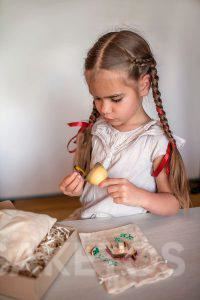
9. Linen bags for decoration – children’s handmade games
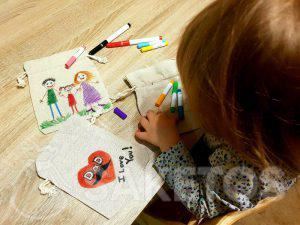
10. A creative game for children – painting linen bags
Do you see how easy it is?! You already know how to make your own DIY bags! Now choose the types of fabrics, colours and bag sizes you’re interested in from the wide range offered by the store. Create them on your own or together with your child and discover great ideas for games with sensory bags!
